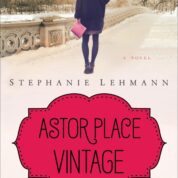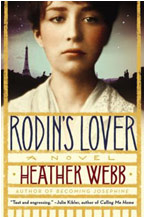
I’m delighted to welcome Stephanie, (hilarious) author of five novels including THE ART OF UNDRESSING & THOUGHTS WHILE HAVING SEX. This month her latest novel–ASTOR PLACE VINTAGE about a New York vintage shop, a mysterious journal, and a journey to the Victorian era–released to much anticipation.
 About the Book:
About the Book:
Amanda Rosenbloom, proprietor of the Astor Place Vintage clothing shop in New York City, thinks she’s on just another call to appraise and possibly purchase clothing from a wealthy, elderly woman. When she discovers a journal sewn into a fur muff, Amanda gets much more than she bargained for. The journal is written in 1907 by Olive Westcott, a young woman who is set on pursuing a career as a department store buyer in an era when Victorian ideas, limiting a woman’s sphere to marriage and motherhood, are only beginning to give way to modern ways of thinking. Astor Place Vintage follows the story of these two women, who are connected in ways neither could’ve imagined.
Your other novels take place in contemporary Manhattan. What tempted you to dip into the past?
I was ready to do something different this time around, and the idea of setting a story in the past intrigued me. I’ve always loved old photographs that give a window into how people looked and lived in previous generations. And the city itself inspired me. Manhattan has a way of making me feel that the past is still present, and those of us who live here now are insignificant. (Much as New Yorkers like to feel otherwise.) The architecture is a constant reminder that New York City will continue on, but we’re only temporary visitors.
Then I read THE LADIES PARADISE by Emile Zola. It’s set in a huge department store in 1860s Paris, and the story centers on a young woman who arrives in Paris without any money and takes a job as a shopgirl. I decided to use the setting of a department store in my novel. And I quickly realized that store would be Siegel-Cooper, the original occupant of the most beautiful Beaux-Arts building on 18th Street and Sixth Avenue. It’s now a Bed, Bath and Beyond, TJ Maxx, and Marshall’s.
Since I’d never written a historical novel, I felt reassured by the idea of framing the story with a character from the present. So for the contemporary story, I hit on the idea of a vintage clothing store owner. It made perfect sense. Amanda, the modern character, would romanticize the past, and Olive, the character from the past, would aspire to being modern. But people who read early drafts kept asking for more of Amanda. By the time the manuscript was done, every chapter alternated between the two characters.
 Edwardian hats and dresses! Who doesn’t love them? Can you share a juicy tidbit while researching and a photo?
Edwardian hats and dresses! Who doesn’t love them? Can you share a juicy tidbit while researching and a photo?
Well, if we want a juicy tidbit, I think we should take a look and see what was under those long skirts. When I began to write, I had no idea what kind of underwear women wore in those days. When it came time to write a scene where a certain male character helps Olive take off her clothes, I needed to find out.
Around the turn of the 20th century, women didn’t wear “panties” such as we think of them today. They wore “drawers,” which were also sometimes called pantaloons or bloomers. These were most likely made out of cotton and lace, tied closed at the waist, and could vary in length from mid-thigh to calf. What I found surprising is that most women wore crotchless drawers. It makes sense, though, if you think about how they didn’t have elastic waistbands then, and it would be quite a hassle when “relieving yourself” to untie your drawers and pull them down while hiking up skirts and petticoats.
Eventually petticoats went out of style, and by the second decade of the century women preferred drawers with closed crotches.
When the going gets rough and you’re stuck on a plot point, how do you muddle through?
I’ve always found writing dialogue easier than straight prose. So if I have to get through a section that I’m unsure about for whatever reason, sometimes I’ll just speed through with my characters talking. No exposition, just a back and forth between two characters. At least I’m moving forward. Sometimes their conversation helps me figure out where to go or what needs to happen.
Other muddle-conquering techniques include short naps, long showers, strong coffee, and the most tried and true method of all – writing countless pages that end up in the garbage until I finally figure out what the heck I’m doin
Is there anything you would have done differently on your own path to publication?
Well, certainly the glaringly obvious mistake I made was failing to write a bestseller. I will never forgive myself for straying from this path, which I seem to do over and over.
As far as advice goes, I will say that one aspect of my character helped me get published more than anything else, and that’s stubbornness. My first novel published was actually the fourth novel that I wrote. Over the years, no matter how many rejection letters came my way, I didn’t stop writing. So my best advice to aspiring writers is to be persistent, bullheaded, and obstinate.
SPEED ROUND
Deli or cafe?: Cafe
Best Place on Earth: Cafe
Hidden Talent: Able to spend many consecutive hours in cafes.
 Biggest Vice: Compulsion to make dumb jokes – especially while sitting in cafés.
Biggest Vice: Compulsion to make dumb jokes – especially while sitting in cafés.
ABOUT THE AUTHOR
Stephanie Lehmann received her B.A. at U.C. Berkeley and an M.A. In English from New York University. She has taught novel writing at Mediabistro and online at Salon.com, where her essays have been published. Like Olive and Amanda, she lives in New York City.
Find her here: www.AstorPlaceVintage.com OR www.StephanieLehmann.com













